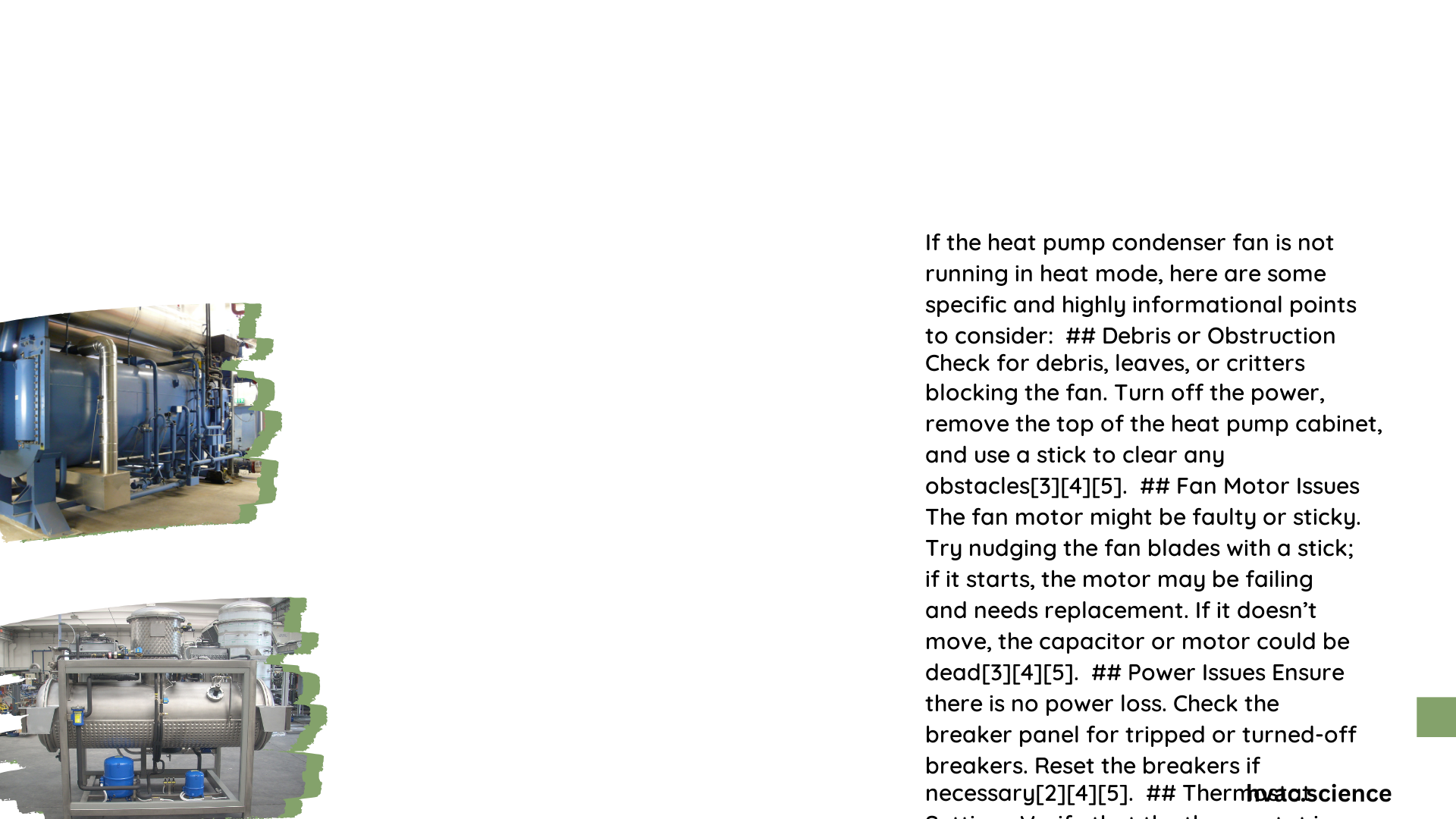A heat pump condenser fan not running in heat mode can significantly impact your home’s heating efficiency. This issue often stems from power supply problems, thermostat malfunctions, debris blockages, or component failures. Understanding the causes and solutions can help homeowners troubleshoot and potentially resolve the problem, ensuring optimal heat pump performance during colder months.
Why Is My Heat Pump Condenser Fan Not Running in Heat Mode?
The condenser fan plays a crucial role in the heat pump’s operation, especially in heat mode. When it fails to run, several factors could be at play:
Is It a Power Supply Issue?
One of the most common reasons for a non-functioning condenser fan is a power supply problem. This can manifest in several ways:
- Tripped circuit breaker: Check your electrical panel to ensure the circuit breaker for the heat pump hasn’t tripped.
- Faulty wiring: Damaged or loose wiring can prevent power from reaching the fan motor.
- Blown fuse: If your system uses fuses, a blown fuse can cut power to the fan.
To troubleshoot:
– Inspect the circuit breaker and reset if tripped
– Look for any visible signs of wire damage
– Test the voltage at the disconnect box near the outdoor unit
Could the Thermostat Be the Culprit?
A malfunctioning thermostat can prevent the condenser fan from receiving the signal to run. Consider these points:
- Incorrect settings: Ensure the thermostat is set to ‘Heat’ mode and the temperature is set higher than the current room temperature.
- Faulty thermostat: A defective thermostat may not send the proper signals to your heat pump system.
- Wiring issues: Loose or damaged wiring between the thermostat and the heat pump can disrupt communication.
Troubleshooting steps:
1. Check thermostat settings
2. Replace batteries if applicable
3. Inspect wiring connections
Are There Any Debris or Blockages?
Physical obstructions can prevent the fan from spinning freely:
- Ice accumulation: In cold weather, ice can form on the fan blades or surrounding components.
- Leaves and debris: Outdoor debris can accumulate in the unit, blocking the fan.
- Small animals: Sometimes, small animals can nest in the unit, causing blockages.
To address this:
1. Turn off power to the unit
2. Remove the top grille
3. Clear any visible debris or ice
4. Gently test if the fan spins freely by hand
Is the Fan Motor Faulty?
A worn-out or defective fan motor can cause the fan to stop running:
- Age-related wear: Over time, motors can degrade and fail.
- Electrical issues: Short circuits or burnouts can render the motor inoperable.
- Bearing problems: Worn bearings can cause the motor to seize.
Signs of a faulty motor:
– Unusual noises when attempting to start
– Motor feels hot to the touch
– Visible damage or burning smell
Could It Be a Capacitor Problem?
The capacitor provides the initial boost of energy to start the fan motor. A failed capacitor can prevent the fan from running:
- Visual signs: Look for bulging, leaking, or discoloration on the capacitor.
- Age: Capacitors typically last 10-20 years but can fail earlier.
- Electrical testing: Use a multimeter to check capacitance (for experienced DIYers or professionals only).
Capacitor replacement cost: Typically between $150-$275, including labor.
What About Relay Issues?
While less common, a faulty relay can also prevent the fan from running:
- Function: The relay acts as a switch, controlling when the fan should turn on or off.
- Symptoms: Fan doesn’t start even when other components are working correctly.
- Testing: Requires electrical knowledge to check relay function with a multimeter.
How Does Heat Mode Differ from Cooling Mode in Fan Operation?

Understanding the operational differences can help diagnose issues:
| Aspect | Heat Mode | Cooling Mode |
|---|---|---|
| Fan Function | Draws in outdoor air for heat extraction | Expels indoor heat to the outside |
| Coil Role | Outdoor coil acts as evaporator | Outdoor coil acts as condenser |
| Fan Operation | Continuous except during defrost cycles | Cycles on and off with compressor |
| Air Flow Direction | Inward through outdoor unit | Outward through outdoor unit |
What Steps Should I Take for Heat Pump Maintenance?
Regular maintenance can prevent many issues with the condenser fan:
- Clean the outdoor unit:
- Turn off power
- Remove debris from fan and coils
-
Wash coils gently if needed
-
Check thermostat function:
- Verify settings
-
Test different modes
-
Inspect electrical components:
- Look for loose connections
-
Check for signs of wear or damage
-
Schedule professional maintenance:
- Twice yearly (before heating and cooling seasons)
-
Comprehensive system check
-
Monitor performance:
- Listen for unusual noises
- Pay attention to heating efficiency
By following these steps and understanding the potential causes of a non-running condenser fan in heat mode, homeowners can often identify and sometimes resolve issues with their heat pump systems. However, when in doubt or dealing with electrical components, it’s always safest to consult with a qualified HVAC professional.
References:
1. https://www.aironetech.com/blog/is-your-heat-pumps-fan-motor-failing-10-signs-to-look-for/
2. https://www.deluxeplumbing.com/knowledge/why-does-my-heat-pump-fan-not-turn-on/
3. https://www.hvac.com/expert-advice/heat-pump-fan-not-spinning/
